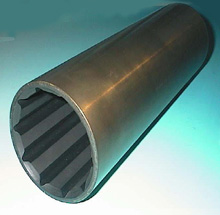 Cutless
bearings refer to rubber lined bearings operating with water lubrication
on an elasto-hydrodynamic principle. The fluted design of the bearing
utilises basis lubrication principles to allow formation of hydrodynamic
water wedges at the bearing surfaces by flow of water from the grooves. Cutless
bearings refer to rubber lined bearings operating with water lubrication
on an elasto-hydrodynamic principle. The fluted design of the bearing
utilises basis lubrication principles to allow formation of hydrodynamic
water wedges at the bearing surfaces by flow of water from the grooves.
Cutless bearings have a wide spectrum of marine applications, which
include propeller shaft bearings in sterntubes or struts, rudder bearings
and cutter bearings, in a variety of craft. Besides marine applications,
cutless bearings are also used in hydroelectric turbines, centrifugal
pumps and other water submersible devices.
When used in propeller shaft housing, the cutless bearing provides
a structural support with built-in resilience that allows the bearing
to yield in sympathy with the bending of the boats structure and thus
prevents shaft bearing misalignment or shaft wear. The bearing also
reduces vibration and the volume of noise being transmitted into the
boat. It also absorbs shock and has an advantage of being almost maintenance
free.
The name cutless is derived from the ability of such bearings to pass
abrasive materials such as sand and marine organisms across its surface
and into the flushing grooves. These abrasive particles do not embed
into the bearing surface and cause little cutting and wearing of the
shaft.
Manufacturing Process
Fluted Cylindrical Cutless Bearing can be prepared either by starve
type bearing whereby the lining is prepared as an individual strip
or by a full moulded bearing design whereby the lining is prepared
as a continuous cylinder, usually press moulded. In both cases, the
lining is usually bonded to a backing shell by an adhesive process.
Cutless bearings were normally made according to fixed length, internal
diameter (I. D.) and outer diameter (O. D.) measurements. Besides
the standard range available in the market, they can also be made
according to request. Grooves in the inner lining can vary in numbers
and size depending on their suitability during service. The lining
material were normally made from ebonite rubber but can also be made
from a softer material.
Compression moulding was normally used with suitable formulated compounds
for both backing shell and the inner liner.

|




